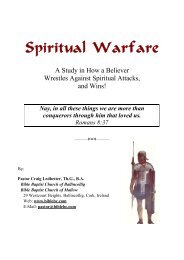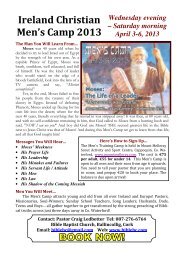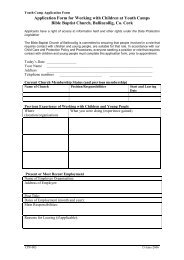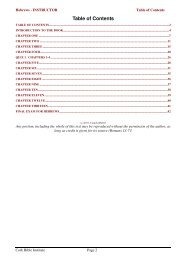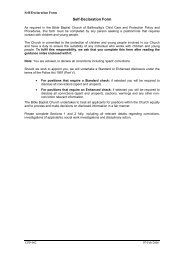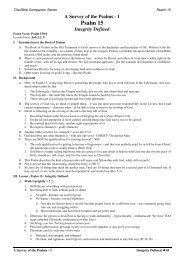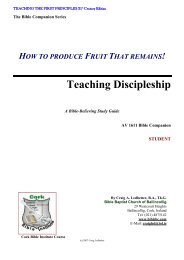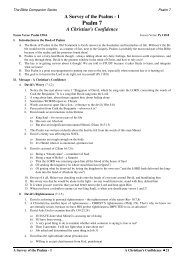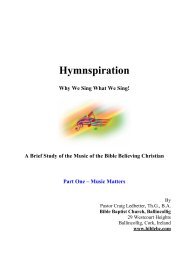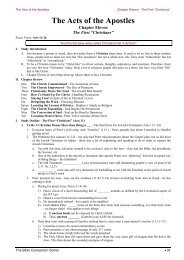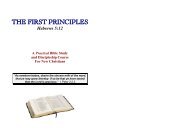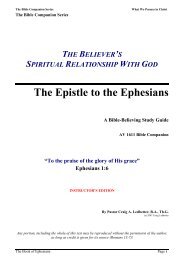Old Testament Survey - Student.pdf - Bible Baptist Church of Blarney
Old Testament Survey - Student.pdf - Bible Baptist Church of Blarney
Old Testament Survey - Student.pdf - Bible Baptist Church of Blarney
Create successful ePaper yourself
Turn your PDF publications into a flip-book with our unique Google optimized e-Paper software.
<strong>Old</strong> <strong>Testament</strong> <strong>Survey</strong> – <strong>Student</strong> Edition<br />
1&2 Chronicles, Ezra, Nehemiah<br />
Esther<br />
The Book <strong>of</strong> Esther is the ________ <strong>of</strong> the Historical books <strong>of</strong> the <strong>Old</strong> <strong>Testament</strong>, and is kind <strong>of</strong> out<br />
<strong>of</strong> sequence because it take the reader back to the time when the nation <strong>of</strong> Judah was captive in Persia,<br />
but it is a record <strong>of</strong> how God miraculously protected it as a nation from genocide – complete<br />
destruction.<br />
Author: The Book <strong>of</strong> Esther does not specifically name its author. The most popular traditions are<br />
Mordecai (a major character in the Book <strong>of</strong> Esther) and Nehemiah (who would have been familiar<br />
with Persian customs).<br />
Date <strong>of</strong> Writing: The Book <strong>of</strong> Esther was likely written between 460 and 350 B.C.<br />
Key People in the Book:<br />
King Ahasuerus (Artaxerxes, also just called Xerxes) – a very powerful Persian ruler <strong>of</strong> the day<br />
Vashti – his beautiful queen who rejects his commands once too <strong>of</strong>ten<br />
Mordecai – a godly Jew who had been carried captive into Babylon, and was taking care <strong>of</strong> his<br />
niece Hadassah (Esther) since her parents had been killed<br />
Haman – a wicked, selfish second-in-command over Persia who hated the Jews and attempts to<br />
just have them exterminated, but dies by his own invention<br />
Esther – her Jewish name was “Hadassah”<br />
Purpose <strong>of</strong> Writing: The purpose <strong>of</strong> the Book <strong>of</strong> Esther is the recording <strong>of</strong> the institution <strong>of</strong> the<br />
Feast <strong>of</strong> Purim and the obligation <strong>of</strong> its perpetual observation. The Book <strong>of</strong> Esther is read at the<br />
yearly Feast <strong>of</strong> Purim to commemorate the great deliverance <strong>of</strong> the Jewish nation brought about by<br />
God through a young lady named Esther. The noble Esther risked her own death as she realized what<br />
was at stake. She willingly did what could have been a deadly manoeuvre as she faced <strong>of</strong>f with the<br />
second in command <strong>of</strong> her husband‘s kingdom, Haman. She proved a wise and most worthy<br />
opponent, all the while remaining humble and respectful <strong>of</strong> the position <strong>of</strong> her husband-king.<br />
Much like the story <strong>of</strong> Joseph in Genesis 41:34-37, both stories involve foreign monarchs who control<br />
the destiny <strong>of</strong> the Jews. Both accounts show the heroism <strong>of</strong> Israelite individuals who provide the<br />
means for the salvation <strong>of</strong> their people and nation. The hand <strong>of</strong> God is evident, in that what appears to<br />
be a bad situation is indeed very much under the control <strong>of</strong> the Almighty God who ultimately has the<br />
good <strong>of</strong> the people at heart. At the centre <strong>of</strong> this story is the ongoing divergence between the Jews and<br />
the Amalakites, which was recorded to have begun in the Book <strong>of</strong> Exodus. Haman’s goal is the final<br />
effort recorded in the <strong>Old</strong> <strong>Testament</strong> period <strong>of</strong> the complete eradication <strong>of</strong> the Jews. His plans<br />
eventually end up with his own demise, and the elevation <strong>of</strong> his enemy Mordecai to his own position,<br />
as well as the salvation <strong>of</strong> the Jews.<br />
Key Verses: Esther 4:14; Esther 6:12; Esther 7:3<br />
Brief Summary: Feasting is a major theme <strong>of</strong> this book, there are ten recorded banquets, and many<br />
<strong>of</strong> the events were planned, plotted or exposed at these banquets. Although the name <strong>of</strong> God is never<br />
mentioned in this book, it is apparent that the Jews sought His intervention when they fasted and<br />
prayed for three days (Esther 4:16). In spite <strong>of</strong> the fact that the law allowing their destruction was<br />
written according to the laws <strong>of</strong> the Medes and Persians, rendering it unchangeable, the way was<br />
cleared for their prayers to be answered. Esther risked her life by going not once uninvited before the<br />
king but twice, (Esther 41:2; 8:3). She was not content with the destruction <strong>of</strong> their enemy, Haman;<br />
she was more intent on saving her people. The institution <strong>of</strong> the Feast <strong>of</strong> Purim is written and<br />
preserved for all to see and is still observed today. God's chosen people, without any direct mention <strong>of</strong><br />
His name, were granted a stay <strong>of</strong> execution through the wisdom and humility <strong>of</strong> Esther.<br />
Practical Application: The Book <strong>of</strong> Esther shows the choice we make between seeing His hand in<br />
our circumstances in life and seeing things as merely coincidence. One can be assured that His plans<br />
will not be moved by the actions <strong>of</strong> mere evil men. One cannot but to see the Almighty exerting<br />
CBI - Practical Doctrine Page 61



